Guildgates and gold cards and Cluestones—oh my! On the cityscape plane of Ravnica, mana is bountiful. The last time we were here, we had bouncelands (Orzhov Basilica) and Signets (Boros Signet) and could play just about anything, splashing to our hearts’ content. We have just as much mana fixing this time around with our Guildgates and Cluestones, but something is a little different. The Guildgates don’t facilitate making land drops like the bouncelands did, and the extra mana on the cost of the Cluestones makes a world of difference.
This past weekend, I placed in the Top 4 of the first ever StarCityGames.com Sealed Open in Charlotte, and I’d like to go over my sorting and thought process for building my Sealed deck. With ten guilds, ten Guildgates, and ten Cluestones to choose from, building a Sealed deck in the current format is a bit more daunting than previous blocks. Sometimes you have to keep that Ral Zarek in your sideboard even though you’re already playing red.
Many Guilds—Handle Them!
After you open your packs, it’s natural to want to sort your pool into guilds since that’s what we’re used to doing. Return to Ravnica and Gatecrash only had five guilds each and were both standalone sets, so sorting into guilds was easily manageable. I have a tough time trying to organize my closet, let alone ten individual guilds, five colors, artifacts/nonbasic land, and hybrid cards—what a nightmare!
A more eloquent and less nightmare inducing method that I like to use is to first sort the cards into nine piles: respective colors (white, black, blue, red, green), gold cards, hybrid cards, artifacts, and nonbasic lands. This is a pretty normal way of sorting your pool; however, it is really easy to want to sort out the gold cards into guilds like we’re used to so that we can see what we’re working with. I believe that sorting this way first is much more beneficial for a few reasons.
The first is time. Time is a real factor when building Sealed decks in this format since we have so many options and different configurations with each guild and combinations of guilds. By sorting cards this way, you reduce the number of stacks of cards that you have to go through, which makes it easier to evaluate cards.
It also helps to keep you calm. Keep calm and build decks. When you have ten guild piles, five color piles, and piles for hybrid cards, colorless cards, and nonbasic lands, it’s pretty easy to get overwhelmed and miss something.
Once you have your cards sorted this way, the next step is to go through each stack and sort out the playable cards. I like to pull out potential sideboard cards as well like Mindstatic and Riot Control just to save myself a few extra seconds. While you are doing this, there are a few specific things you want to be keeping a mental note of: removal, ways to kill your opponent, mana fixing (Guildgates and Cluestones), mana curve (how many of each casting cost you are looking at and how games will play out), and cards with hefty mana requirements. These are the types of things you want to be looking for while you are pulling out your playable cards to help steer you in a direction for building.
Example from #SCGCHAR
I’d like to use my deck from the Sealed Open last weekend as an example of this method because I employed it and felt like I made some correct decisions in building.
Nonbasic Land
Golgari Guildgate
Selesnya Guildgate
Transguild Promenade
Orzhov Guildgate
Rakdos Guildgate
Selesnya Guildgate
Artifact
Selesnya Keyrune
Street Sweeper
Riot Gear
Boros Cluestone
Golgari Cluestone
Orzhov Cluestone
White
Azorius Arrester
Eyes in the Skies
Shielded Passage
Lyev Decree
Scion of Vitu-Ghazi
Steeple Roc
Blue
Isperia’s Skywatch
Stealer of Secrets
Cloudfin Raptor
Last Thoughts
Mindeye Drake
Scatter Arc
Hidden Strings
Maze Glider
Uncovered Clues
Wind Drake
Black
Catacomb Slug
Dark Revenant
Dead Reveler
Mind Rot
Terrus Wurm
Devour Flesh
Grisly Spectacle
Gutter Skulk
Killing Glare
Midnight Recovery
Maze Abomination
Red
Annihilating Fire
2 Cobblebrute
Dynacharge
Explosive Impact
Survey the Wreckage
Act of Treason
Bomber Corps
Structural Collapse
Tin Street Market
Punish the Enemy
Rubblebelt Maaka
Smelt-Ward Gatekeepers
Green
Axebane Stag
Gobbling Ooze
Rubbleback Rhino
Adaptive Snapjaw
Crowned Ceratok
Disciple of the Old Ways
Verdant Haven
Maze Behemoth
Mending Touch
Thrashing Mossdog
Multicolored
Dramatic Rescue
Dreadbore
Izzet Charm
Supreme Verdict
Thoughtflare
Frenzied Tilling
Ghor-Clan Rampager
Martial Glory
Zhur-Taa Swine
Ascended Lawmage
Bronzebeak Moa
Gleam of Battle
Morgue Burst
Ral Zarek
Showstopper
Tithe Drinker
Viashino Firstblade
Zhur-Taa Druid
Hybrid
Burning-Tree Emissary
Immortal Servitude
Nightveil Specter
Split
As I was sorting out all of my playable cards, I was immediately drawn to the removal because there was a lot of it:
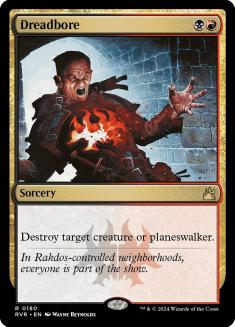
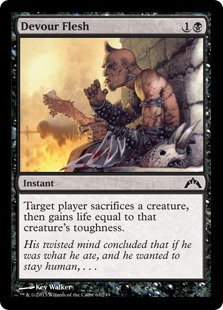
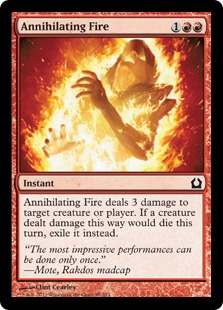
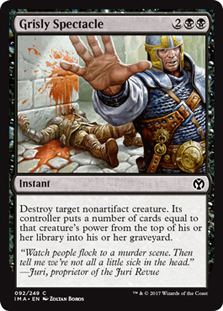
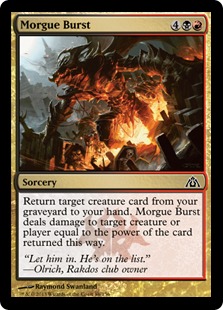
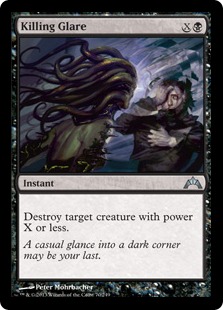
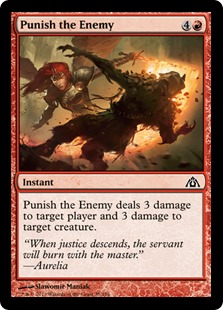
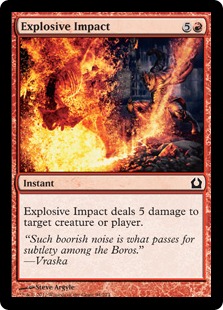
With that much removal, I had myself set in Rakdos and started to look at what other cards I could pair with this potential deck’s ability to make all the bad guys go away. The plethora of removal wasn’t the only thing that jumped out at me though.
Ral Zarek, Supreme Verdict, and Scion of Vitu-Ghazi are all bomb rares. I really wanted to play Ral Zarek, so my first attempt at a build was Grixis. As I started building my deck (creatures on top, "spells" on bottom lined up by converted mana cost), I had to ask myself a serious question.
"How am I going to kill my opponent?"
If I went Grixis, I had a Wind Drake, an Isperia’s Skywatch, and a Ral Zarek as the only "real" cards that I could see myself killing my opponent with. I also didn’t have any Guildgates that provided blue mana, although I did have a Transguild Promenade. Sad that Grixis wasn’t going to work, I looked at Orzhov splashing blue and red because I really wanted to play Ral Zarek!
This deck was much better than the Grixis Deck, with an Orzhov Guildgate and some Cluestones to help fix my mana in addition to a Rakdos Guildgate to help with the red splash. I wouldn’t be able to play Annihilating Fire, but the rest of the removal with red in its casting cost was splashable. Morgue Burst returning a Scion of Vitu-Ghazi just seemed awesome. Unfortunately, this variation of the deck lacked an actual way to kill my opponent as well. I gained Scion of Vitu-Ghazi and a Steeple Rock but was sacrificing a lot of consistency by playing four colors without a bunch of Guildgates and Cluestones.
Finally, I looked to green to finish my opponent. Once I let go of Ral Zarek (I’m sorry buddy!), I realized that I had some awesome green creatures and some really sweet bloodrush guys to kill creatures and opponents and get maximum value out of my Morgue Burst. Here’s the Jund list I played:
Creatures (13)
- 1 Dead Reveler
- 1 Rubbleback Rhino
- 1 Burning-Tree Emissary
- 1 Zhur-Taa Swine
- 1 Ghor-Clan Rampager
- 1 Gutter Skulk
- 1 Bomber Corps
- 1 Adaptive Snapjaw
- 1 Crowned Ceratok
- 1 Disciple of the Old Ways
- 1 Rubblebelt Maaka
- 1 Thrashing Mossdog
- 1 Zhur-Taa Druid
Lands (7)
Spells (20)

The only real mistake I made was playing the miserable Bomber Corps, and I ended up siding it out every match for Cobblebrute or Wear // Tear. I had two Selesnya Guildgates and an Orzhov Guildgate, so bringing in a couple of them in addition to the Transguild Promenade and Verdant Haven I already had, it’s very feasible to get extra value of the Wear // Tear.
I’d like to talk about Wear // Tear a little bit because I feel like I have a unique perspective on it. This Sealed format is all about consistency and powerful cards. Cluestones play right into both of these two "ideals" of the Sealed format by fixing your mana and accelerating you into your powerful spells. There are some amazing five, six, and seven casting cost commons and uncommons that come close to just winning you the game when you cast them—Trostani’s Summoner being the biggest culprit. In addition to Cluestones, there are some awesome enchantments that are playable in this format, and they all have a huge impact on the game:
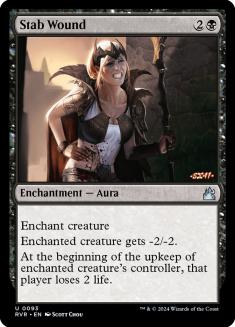
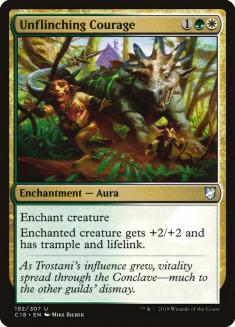
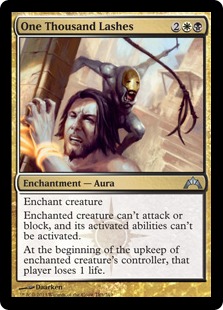
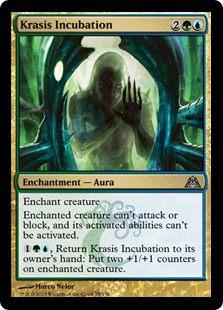
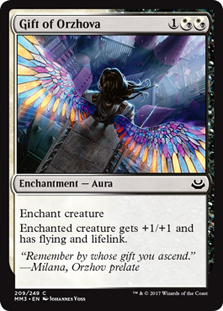
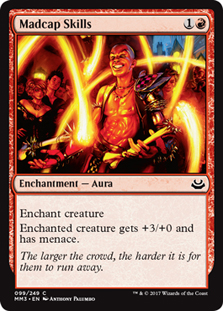
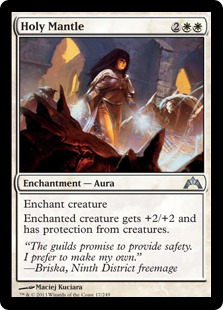
These are all cards you can expect to play against, and there are many others that I didn’t even list. These reasons lead me to believe Wear // Tear is a great option for a maindeck slot when building a Sealed deck. Just killing a Cluestone the opponent used their turn to cast is sometimes good enough, and if you ever get to Hull Breach anyone, it’s just backbreaking.
Having access to white for Tear made me want to bring in my Bronzebeak Moa when I was siding in Wear // Tear (which was every round), but I held strong. Bronzebeak Moa is an awesome card, and if you build your deck around abusing it (Trostani’s Summoner strikes again), it is a Moa Monster. I didn’t want to be casting my creatures all "willy-nilly" to pump Bronzebeak Moa—no sir, I had a plan. I was just going to kill them. Kill them all.
Here is an excerpt from one of my games against Roanoke local Ryan Neal:
Turn 2: Gutter Skulk.
Turn 3: Kill your three-drop and attack for two.
Turn 4: Kill your four-drop and attack for two.
Turn 5: Punish the Enemy your five-drop (Wrecking Ogre—BINK!) and attack for two.
Turn 6: Kill your creature and attack for two.
Turn 7: Attack for two. You ran out of creatures? Double bloodrush (Ghor-Clan Rampager and Zhur-Taa Swine) for eleven and exactsies.
Death by Gutter Skulk.
This is how most of my games went. Since I had literally all the removal, I didn’t need to flood the board with creatures. I just needed to have one or two and to remove all of their blockers. Burning-Tree Emissary was great for this. I never got to live the dream of Burning-Tree Emissary into Zhur-Taa Druid, but I did get to Burning-Tree Emissary into Dead Reveler on turn 3 and Burning-Tree Emissary into Cobblebrute or Thrashing Mossdog on turn 4 multiple times. It’s no Flinthoof Boar, but it’s still a lot of pressure.
The last unique decision I made was choosing to not start Explosive Impact. In my deck, most of the time it was going to be used as a removal spell, which is the wrong role for the card. I feel like Explosive Impact is best going to the dome most of the time, which makes it a perfect card for a Boros or a Naya Bloodrush deck. You want its secondary mode to be a removal spell, not the other way around. I’m not saying that it’s a bad card and that it can’t be used in this manner effectively; I just felt that with all of the other removal that I had, Explosive Impact wasn’t going to be good enough most of the time. I did bring it in against a deck with Korozda Gorgon, but that was it.
Top 8 Draft
Since the Top 8 was Draft, I’d like to go over my Draft deck a little bit. I still feel like it was a good deck—it was just a few cards from being really awesome. I would have liked another one or two Guildgates and should have had a Viashino Firstblade in my deck, but I made a rash decision that didn’t pan out. Here’s the decklist:
Creatures (14)
- 1 Wind Drake
- 1 Cinder Elemental
- 1 Cobblebrute
- 2 Frostburn Weird
- 2 Splatter Thug
- 1 Simic Fluxmage
- 1 Hellraiser Goblin
- 1 Leyline Phantom
- 2 Wojek Halberdiers
- 1 Nivix Cyclops
- 1 Blaze Commando
Lands (1)
Spells (25)
- 6 Plains
- 6 Mountain
- 4 Island
- 1 Izzet Charm
- 1 Annihilating Fire
- 1 Swift Justice
- 1 Pit Fight
- 1 Martial Glory
- 1 Wear
- 1 Turn
- 1 Azorius Cluestone
- 1 Warleader's Helix
Sideboard
- 1 Paralyzing Grasp
- 1 Goblin Electromancer
- 1 Blistercoil Weird
- 1 Chemister's Trick
- 1 Stonefare Crocodile
- 1 Duskmantle Guildmage
- 1 Zarichi Tiger
- 1 Spell Rupture
- 1 Ivy Lane Denizen
- 1 Hydroform
- 1 Purge the Profane
- 1 Rot Farm Skeleton
- 1 Boros Cluestone
- 1 Rakdos Cluestone
- 1 Hidden Strings
- 2 Mindstatic
- 1 Plasm Capture
- 1 Rakdos Drake

In the first pack, I took Turn // Burn as my first pick. My second pick was between Rakdos Drake and Viashino Firstblade. I have quite the love for Rakdos Drake in Draft because it plays a great role in a lot of decks. It’s fantastic in both Jund Bloodrush and Grixis and is still a solid card in straight up Rakdos or Dimir. It’s great at pushing through damage so that you can kill your opponent out of nowhere with your bloodrush guys, and it’s a great target for cipher spells like Hidden Strings and Hands of Binding.
Unfortunately, Brian Braun-Duin was to my right and passing to me in this pack, and I knew that he loves to draft decks with black. Esper, G/W/B, and Golgari are among some of the decks that I would normally put him on, but I was blinded by the Rakdos Drake. He taunted me. He offered me power, I accepted, and I ultimately paid the price.
I took my little aggro deck pretty far and made it into the Top 4, but in the end it didn’t matter because Joshua Snyder had a pretty bonkers Bant deck and crushed me easily. Since we were in opposite brackets and could only meet in the finals, I was rooting for BBD because I know he really wants a trophy, but alas, it was not to be. Congratulations to Joshua for winning the first ever Sealed Open, and congratulations to StarCityGames.com own Anthony "Scooby" Kando for earning his first Open Series Top 8.
This coming weekend the Open Series returns to Nashville, Tennessee. I have a pretty fond memory of Nashville, as it’s where I hit Level 8 the first year I was grinding the Open Series thanks to Matt Hoey and Todd Anderson. I’m not sure if I’m going to make it out there this weekend, but if I do, you might see me Slimeing and Working some Metal.
I’d love to see any comments about my Sealed pool and your thoughts on how you would have built the deck differently. I also have been bringing my chess set with me when I travel to Opens for BBD and me to play in between rounds, but I’d love to play a game with anyone who’d like to. Feel free to say hi and challenge me to a duel!
See you next week.
<3 CVM
@Chris_VanMeter on Twitter
